Communication Game Part 2: Can You Build a Structure with a Partner, without using words?
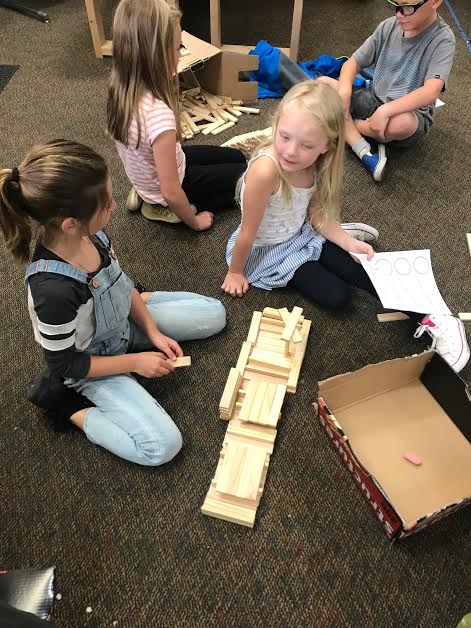
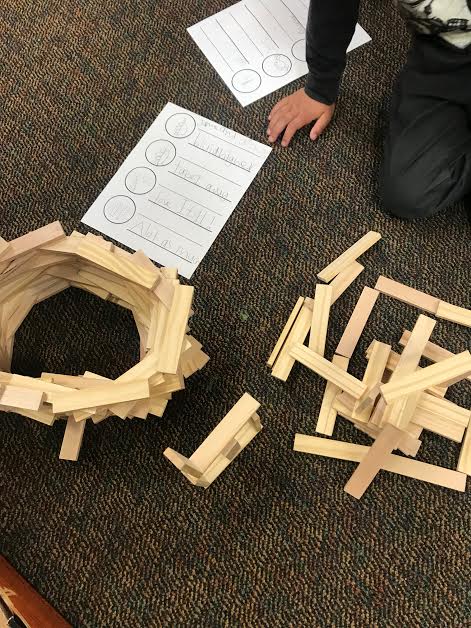
We love getting to bring Science in the Maker's Space! Next, we will be wrapping up this unit and creating a fun book to keep to help us remember all we learned about Light, Sounds, and Heat Energy!
Ms. Gillis
Check this blog out to learn about what is happening with 1st Grade in the S.T.R.E.A.M. Lab throughout the year.
Color Communication Game!
Our Warm Up:
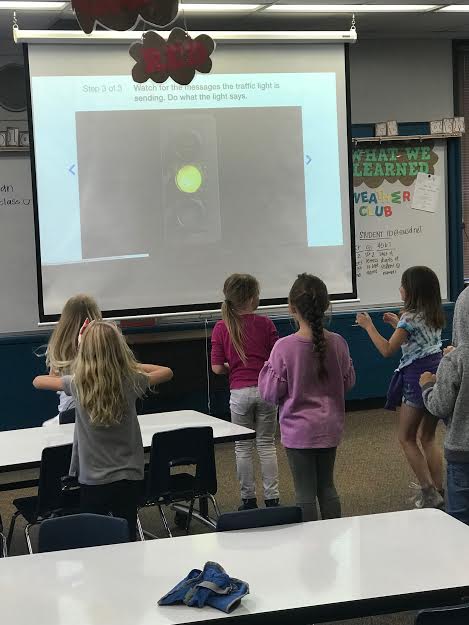
Creating Our Own Game:
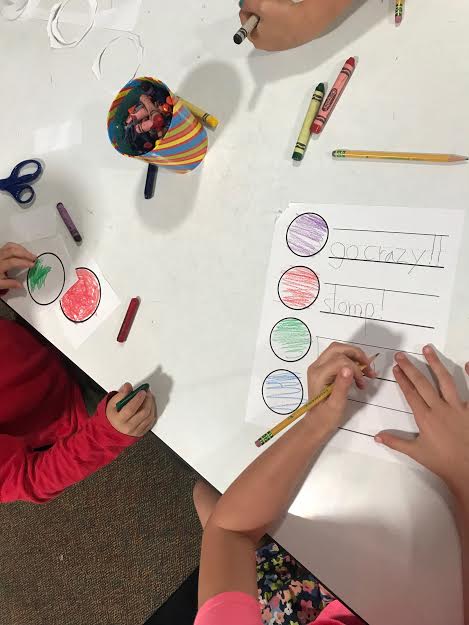
Then, it was our turn in the Maker's Space! We came up with 4 different signals to use with our partner to help us build a structure without using ANY sounds! It was difficult at first but we got the hang of it pretty quickly.
Now that we are wrapping up our unit on Light, Sounds, and Communication, we are going to start to study animals and offspring again, this time becoming researchers and using technology to create an Explain Everything Exploration!
Ms. Gillis
Check this blog out to learn about what is happening with 1st Grade in the S.T.R.E.A.M. Lab throughout the year.
Can You Match the Sound?
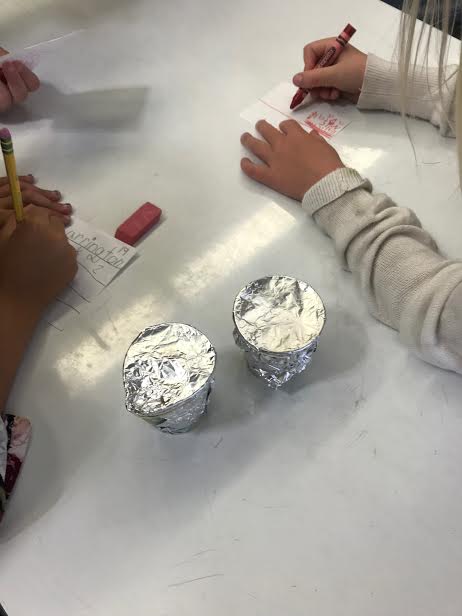 and
and 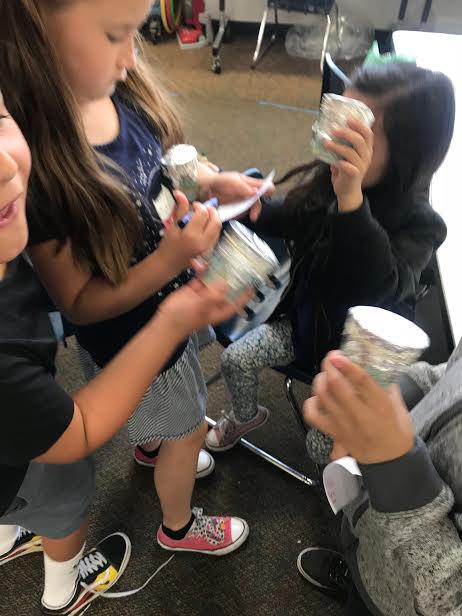
We loved this activity and getting to explore our senses. Next up, we will use all our new knowledge about lights and sound to see if we can solve a problem: Communicating with someone long distance, without using a telephone and without being able to hear them talk! Let's see if we can put on our Engineering hats and figure this one out!
Keep Exploring,
Ms. Gillis
Check this blog out to learn about what is happening with 1st Grade in the S.T.R.E.A.M. Lab throughout the year.
Transparent, Translucent, and Opaque: When to use each!
Then we had a great discussion about when to use each. Students determined that if we wanted to let light in, the plastic wrap or sheet projector was our best bet out of the materials we had! Then, we decided that if we want to let light in, but make sure people can't see in, we could use bubble wrap to solve our problem. Last, if we wanted to make sure NO light came in we decided to use the construction paper or the paper bag for the best results. We love getting to explore the world around us!
Keep Exploring,
Ms. Gillis
Check this blog out to learn about what is happening with 1st Grade in the S.T.R.E.A.M. Lab throughout the year.
Jump back in to the S.T.R.E.A.M.!
We also learned we can classify Light in to 3 different categories: Transparent, Translucent, and Opaque!
We discovered that TRANSPARENT means ALL light passes through.
We discovered that TRANSLUCENT means SOME light passes through.
and finally...
We discovered that OPAQUE means NO light passes through.
Then, we got to create our own version of Stain Glass Windows using Tissue Paper and Glad Press N' Seal. Take a look:
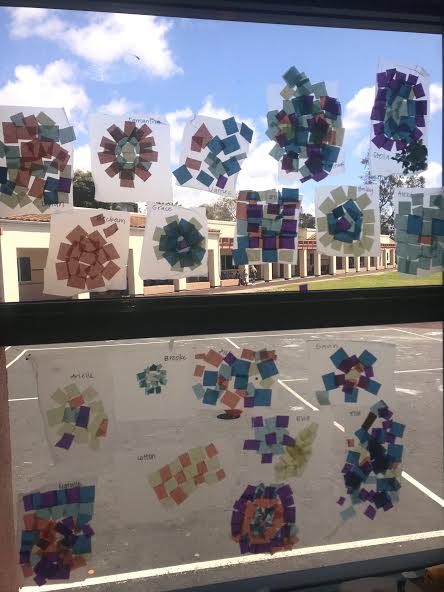 and
and 
Keep Exploring,
Ms. Gillis
Check this blog out to learn about what is happening with 1st Grade in the S.T.R.E.A.M. Lab throughout the year.
Have A Great Spring Break!
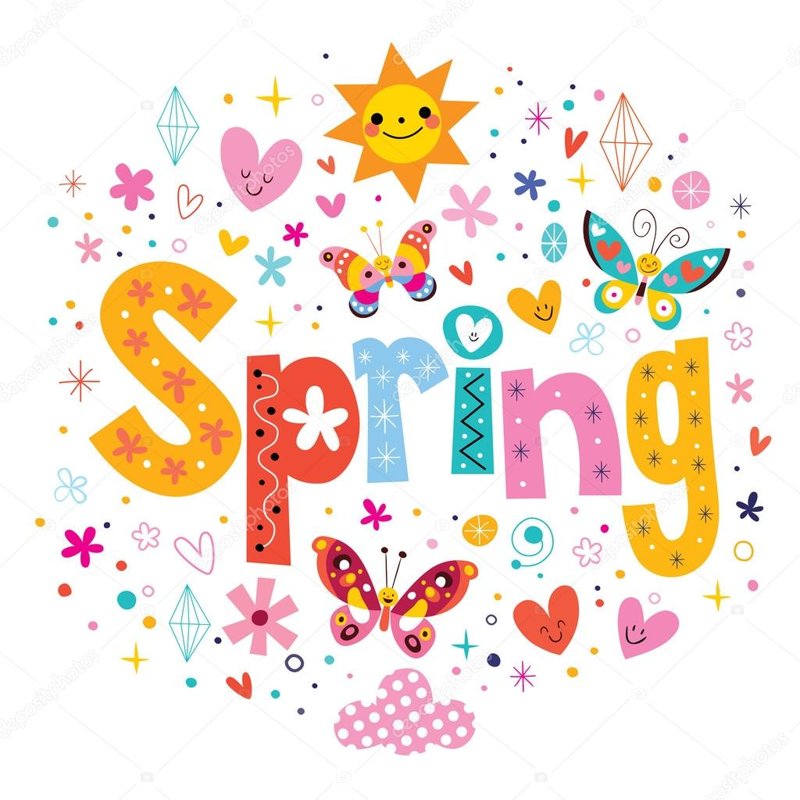
Stay Safe and Keep Exploring!
Ms. Gillis
Building our Instruments!
We came up with some very creative ideas like: rubbing the string along another piece of string, the table, the chair, and more! We also found that we could hold one end of the string under our foot, and pluck it like a guitar string!
Next, Ms. Gillis showed us how to make "Head Harps". We tied the string together, put it on our head and pulled the string tight with our finger (not tight around our heads), then we plucked the string with our fingers! It was so fun to make the sounds by making the vibrations!
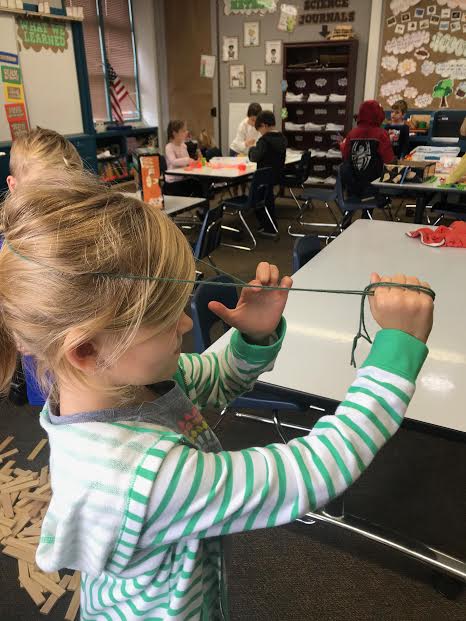
Keep Exploring,
Ms. Gillis
Check this blog out to learn about what is happening with 1st Grade in the S.T.R.E.A.M. Lab throughout the year.
Vibrations and Sounds all Around Us!
Then, we got to work together as a class to recreate the sound of this thunderstorm! It was a lot of fun only using our hands and feet to make so much noise!
Then came time to learn about vibrations! We got to see how vibrations are movements that make sound. We took a ruler and held it off the edge of our tables, then gently pushed down on the edge of the ruler to create a "boing" sound. It was so fun to create the sound effects!
We can't wait to explore more and start to build our own instruments to make our own unique sound!
Keep Exploring,
Ms. Gillis
Check this blog out to learn about what is happening with Kindergarten in the S.T.R.E.A.M. Lab throughout the year.
Using Animal Traits to Protect our Treasures
Now we get to put our new knowledge to a fun test by making our own TREASURE BOX and covering it with different traits animals use to protect themselves! For instance, we have learned how plants like cacti and animals like porcupines and hedgehogs use spikes to protect themselves. We have explored animals who have sharp teeth or claws, animals who have bad smells to scare away predators or big horns, and more! Students are picking all different traits to protect their Treasure Box with! What animal traits would you like to use to protect your treasures?
Keep Exploring,
Ms. Gillis
Check this blog out to learn about what is happening with Kindergarten in the S.T.R.E.A.M. Lab throughout the year.
Nature: The Natural Engineer!
Then, what better to do next then put on our Engineering hats and create a blueprint for our very own Biomimicry Invention based off an animal or plant trait we like! Here are some amazing examples of what our 1st graders came up with:
 and
and 
Next, we are planting seeds to see how different they look as they grow and change (a characteristic of all living things), and explore how the sunlight really affects them!
Keep Exploring,
Ms. Gillis
Check this blog out to learn about what is happening with 1st Grade in the S.T.R.E.A.M. Lab throughout the year.
The Wonderful World of Traits!

Then, we moved on to identifying more unique traits in animals! We focused on traits such as: Hard Scales/Skin, Bad Smell, Spikes on the surface, Sharp Claws, Hard Shell, Horns, and Sharp Teeth. Now that we have identified these traits and found animals that fit in each one (we got to sort out a bunch of pictures as a class and as table groups), we will explore the "Why?" behind each trait! We want to know why certain animals need their sharp claws, or why they have hard shells when other animals in their habitat might not. It is so fun learning about the world around us!
Keep Exploring,
Ms. Gillis
Check this blog out to learn about what is happening with 1st Grade in the S.T.R.E.A.M. Lab throughout the year.
Can you See It?
Camouflage is the ability of an animal to blend in with it's surroundings.
We learned all about camouflage and had a great group discussion answering the question, "Why do animals use camouflage?". This is what we came up with:
- "To hide from predators that want to eat them."
-"To make sure predators can't see them if they are looking for them."
-"To hide from prey so they can eat them when they come really close!"
Next, we got to play a fun "I Spy" game in the classroom to find moths hidden on the trees Ms. Gillis made! Take a look and see how many you can find:
 Moth are hidden all around!
Moth are hidden all around! 
We then got to put our new knowledge to the test and create our own Moth's to hide around the S.T.R.E.A.M. Lab. We first started by picking a place, then we got to coloring and creating a moth that would hide in well with those surroundings. Now the S.T.R.E.A.M. Lab is starting to look like it is covered with hidden creatures!

Keep Exploring,
Ms. Gillis
Check this blog out to learn about what is happening with 1st Grade in the S.T.R.E.A.M. Lab throughout the year.
Traits!
We all agreed that in the end, we are grateful to have our hands, especially our opposable thumbs.
We started to discuss where we get our traits from too. This is helping us start to recognize the traits that make us, and all animals, unique! Next we will get to start exploring more animals and find out more about what makes them unique. For instance, did you know that chameleon's can move their eyes in separate directions? How about how an Octopus can camouflage itself to hide from predators?
Want an activity to do with your child? Discuss where all their traits/physical features came from! Where did their eye color, hair color, hair texture, nose, and more, come from? It is fun for our students to start to recognize their traits in their family members!
Keep Exploring,
Ms. Gillis
Check this blog out to learn about what is happening with 1st Grade in the S.T.R.E.A.M. Lab throughout the year.
Exploring Animal Traits!
- "They follow Mom around to stay safe."
- "They follow Mom around to learn what to do, like swim and fly."
-"They follow Mom around to get food and water and make sure predators don't get them."
We then got to study the behavior of some other animals like: how a Robin feeds her babies, how Opossum Mom's carry their babies on their backs, how the Mother Cat will clean her babies, and how Shrews will hold on to each other's tails to make sure they don't get lost!
Next, we will continue to explore Animal Traits by learning how the offspring of animals inherit those unique traits (such as eye color and hair color in humans!) from their parents! We will explore how animals use those traits to survive and thrive in their natural habitat!
Keep Exploring,
Ms. Gillis
Check this blog out to learn about what is happening with 1st Grade in the S.T.R.E.A.M. Lab throughout the year.
Model it in the Maker's Space!
We then got to finish the Unit with an art project where we got to make Constellations to hang in the S.T.R.E.A.M. Lab windows! We poked holes where the stars in our Constellations are and when we put them up to the light so we get to see the "stars" like we do in the night sky!
Next, we will be moving on to a new Unit where we get to find out about Animal Life Cycles, and all the patterns we see among adults and their offspring!
Keep Exploring,
Ms. Gillis
Check this blog out to learn about what is happening with 1st Grade in the S.T.R.E.A.M. Lab throughout the year.
What Stars do you see at Night?
As we came back from Winter Break last week we dove right back in to learning about Patterns in the Sky. This time we focused on the Stars and answered the question, "Do we see the same stars every night?" The answer is, "No!", we get to see different stars at different times throughout the year!
Then, we began learning about Constellations and the patterns that people have seen in the stars for many years. We also found out that during the Winter where we live we can see Orion the Hunter at night! Tonight, see if you can find Orion the Hunter with your child!
Last, we got to finish with a fun art project where we got to create our own Constellation! We learned how to make the pattern first, and how to turn it in to a Constellation and create whatever we wanted! We have been having so much fun learning about the Patterns in the Sky!
Keep Exploring,
Ms. Gillis
Check this blog out to learn about what is happening with 1st Grade in the S.T.R.E.A.M. Lab throughout the year.
The Sun and other Stars!
First we will explore the how and why behind the Earth orbiting the Sun, and you guessed it! The patterns we see in relation to the Sun and Earth (i.e. Earth's revolution around the Sun takes 365 days = 1 year, the daily pattern we see of the Sun rising in the morning and the Sun setting at night).
Next, the Patterns in the Stars! We will discover when we get to see certain Constellations and why! It is fun learning how so many natural features are connected to each other, and how we have adapted those patterns in to our daily lives!
Have a fun and safe Winter Break!
Keep Exploring,
Ms. Gillis
Check this blog out to learn about what is happening with 1st Grade in the S.T.R.E.A.M. Lab throughout the year.
Up High in the Sky!
Sun, Moon, Stars, Clouds (we discussed how they dissolve/dissipate and reform but they are always found in the sky!), Planets, Pollution, and Air!
As we learn about the world around us we will be exploring all the patterns we find in the sky. From the length of time it takes the Earth to orbit the Sun, the lunar cycle, what stars we see at night and why, and more!
Want something to do with your child(ren) at home? At night, before bed, look up at the stars! Have your child begin to find shapes and patterns in what they see. This will help give them a life experience and visual for when we dive deeper in to what stars and patterns we see seasonally!
Keep Exploring,
Check this blog out to learn about what is happening with 1st Grade in the S.T.R.E.A.M. Lab throughout the year.
Sprout Houses and Beyond!
Keep Exploring,
Ms. Gillis
Check this blog out to learn about what is happening with 1st Grade in the S.T.R.E.A.M. Lab throughout the year.
Welcome!
We are kicking off 1st grade in the S.T.R.E.A.M. Lab with a fun Sprout House experiment. We are not only learning about the life cycle of a plant, we are getting to watch it grow right on our windows in the Lab!
What did we do? We took ziploc bags, cotton balls, water, and Verbena (type of flower) seeds and sealed them up. Next, we hung them in the window because what do plants need to survive? Sunlight and water! We sealed the bags so the water wouldn't evaporate and we could create a Green House effect in our bags.
As our plants continue to grow we learn about the water cycle as we start seeing the condensation on our bags. We also learn how to be responsible observers by checking in on our experiment, writing notes, and drawing pictures to help us learn more!
Keep Exploring,
Ms. Gillis
Check this blog out to learn about what is happening in 1st Grade in the S.T.R.E.A.M. Lab throughout the year.